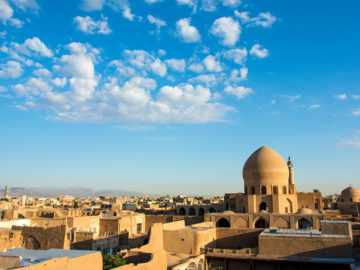
Kashan Carpet
Photo by Fotokon / Shutterstock
Kashan city is located in the north of Isfahan Province, Iran, with a history dating back to 9,000 years. The ruins of the ancient part of the city have remained at the archeological site of Tepe (hill, mound) Sialk. One of the major arts for which the city is famous for its carpet weaving. Kashan has always been a major center of carpet-makers in Iran, more than two-thirds of whom are women. The objects found from Tepe Sialk bears witness to the advanced skills of fabric making by its prehistoric inhabitants.
The first step of making a carpet is choosing a design elaborated with its special motifs. A design with its motifs/patterns are drawn over a graph paper such that each graph cell represents a knot in the carpet. The patterns in a graph paper are drawn in half or quarter of the original size and the weaver will make the whole carpet based on that. The usual patterns used in Kashan carpets are the same as those used in Isfahan cities, such as Flower Vases, Altar, Hunting, Animals, Arabesque pattern, and Lachak Toranj.

Kashan Carpet
Photo by Michal Knitl / Shutterstock
After choosing a desired design for the carpet, the weaving begins on a loom covered with strands of wool also known as warp. The Kashan carpet is made by asymmetrical knotting, a method of weaving called Farsi weaving style as well.
In this style of weaving the colored wool used for weaving passes behind the first strand of warp and then goes around the second, linking the two strands in a knot. The number of knots, usually made of wool and silk, in a square decimeter accounts for 1600 to 1800. The traditional skills of carpet weaving in Kashan was inscribed in 2010 on the Representative List of the Intangible Cultural Heritage of Humanity by UNESCO.


